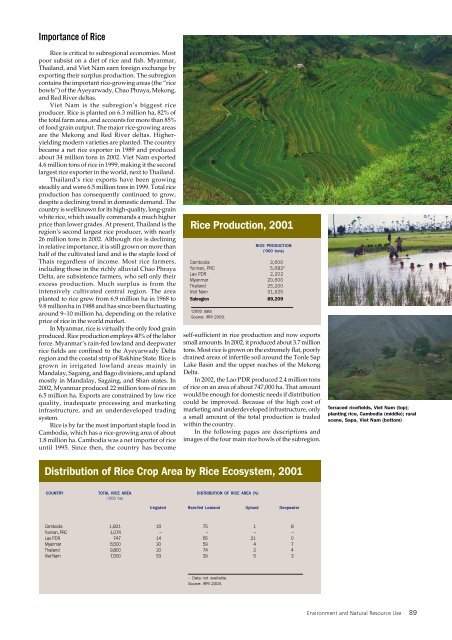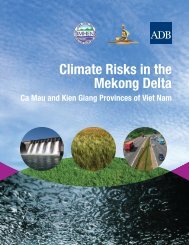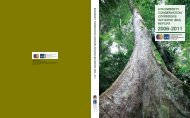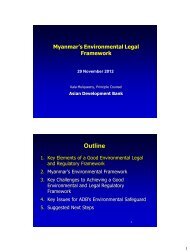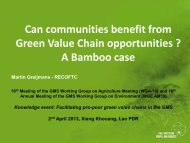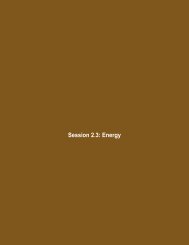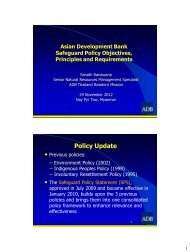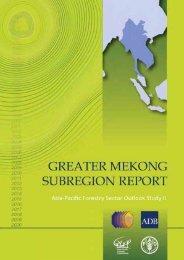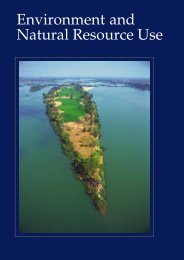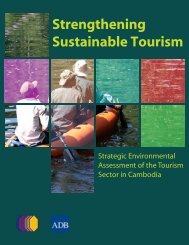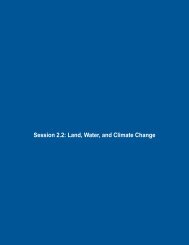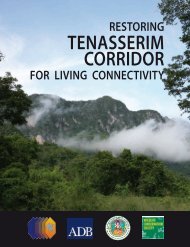You also want an ePaper? Increase the reach of your titles
YUMPU automatically turns print PDFs into web optimized ePapers that Google loves.
Importance of RiceRice is critical to subregional economies. Mostpoor subsist on a diet of rice and fish. Myanmar,Thailand, and Viet Nam earn foreign exchange byexporting their surplus production. The subregioncontains the important rice-growing areas (the “ricebowls”) of the Ayeyarwady, Chao Phraya, Mekong,and Red River deltas.Viet Nam is the subregion’s biggest riceproducer. Rice is planted on 6.3 million ha, 82% ofthe total farm area, and accounts for more than 85%of food grain output. The major rice-growing areasare the Mekong and Red River deltas. Higheryieldingmodern varieties are planted. The countrybecame a net rice exporter in 1989 and producedabout 34 million tons in 2002. Viet Nam exported4.6 million tons of rice in 1999, making it the secondlargest rice exporter in the world, next to Thailand.Thailand’s rice exports have been growingsteadily and were 6.5 million tons in 1999. Total riceproduction has consequently continued to grow,despite a declining trend in domestic demand. Thecountry is well known for its high-quality, long-grainwhite rice, which usually commands a much higherprice than lower grades. At present, Thailand is theregion’s second largest rice producer, with nearly26 million tons in 2002. Although rice is decliningin relative importance, it is still grown on more thanhalf of the cultivated land and is the staple food ofThais regardless of income. Most rice farmers,including those in the richly alluvial Chao PhrayaDelta, are subsistence farmers, who sell only theirexcess production. Much surplus is from theintensively cultivated central region. The areaplanted to rice grew from 6.9 million ha in 1968 to9.8 million ha in 1988 and has since been fluctuatingaround 9–10 million ha, depending on the relativeprice of rice in the world market.In Myanmar, rice is virtually the only food grainproduced. Rice production employs 40% of the laborforce. Myanmar’s rain-fed lowland and deepwaterrice fields are confined to the Ayeyarwady Deltaregion and the coastal strip of Rakhine State. Rice isgrown in irrigated lowland areas mainly inMandalay, Sagaing, and Bago divisions, and uplandmostly in Mandalay, Sagaing, and Shan states. In2002, Myanmar produced 22 million tons of rice on6.5 million ha. Exports are constrained by low ricequality, inadequate processing and marketinginfrastructure, and an underdeveloped tradingsystem.Rice is by far the most important staple food inCambodia, which has a rice-growing area of about1.8 million ha. Cambodia was a net importer of riceuntil 1995. Since then, the country has becomeRice Production, 2001RICE PRODUCTION(‘000 tons)Cambodia3,600aYunnan, PRC5,682Lao PDR2,202Myanmar20,600Thailand25,200Viet Nam31,925Subregion 89,209a2000 dataSource: IRRI 2003.self-sufficient in rice production and now exportssmall amounts. In 2002, it produced about 3.7 milliontons. Most rice is grown on the extremely flat, poorlydrained areas of infertile soil around the Tonle SapLake Basin and the upper reaches of the MekongDelta.In 2002, the Lao PDR produced 2.4 million tonsof rice on an area of about 747,000 ha. That amountwould be enough for domestic needs if distributioncould be improved. Because of the high cost ofmarketing and underdeveloped infrastructure, onlya small amount of the total production is tradedwithin the country.In the following pages are descriptions andimages of the four main rice bowls of the subregion.Terraced ricefields, Viet Nam (top);planting rice, Cambodia (middle); ruralscene, Sapa, Viet Nam (bottom)Distribution of Rice Crop Area by Rice Ecosystem, 2001COUNTRYTOTAL RICE AREA(‘000 ha)DISTRIBUTION OF RICE AREA (%)Irrigated Rain-fed Lowland Upland DeepwaterCambodiaYunnan, PRCLao PDRMyanmarThailandViet Nam1,8211,0747476,5009,8007,50016–1430205375–655974391–214258–0743– Data not available.Source: IRRI 2003.Environment and Natural Resource Use 89


